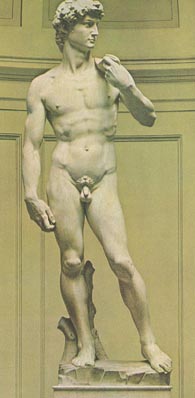History of the Stone used to carve the David

|
"The orgins of the stone are complicated. The block
from which the David was carved had become the
property of the republic of Florence in 1501.
The stone had been acquired as early as 1464 when there had been a scheme to decorate the tribune buttresses of the cathederal with giant statues of Old Testament prophets. The idea for this decorative plan dated back to 1410 when Donatello had started work on carving a giant prophet, described as a white giant in 1412. Nothing further was done for the next fifty years. Donatello was once again in Florence when a statue of a giant- possibly Hercules - was completed in terracotta in 1564 by Agostino di Duccio. When Donatello died in 1466, Rossellino was entrusted with continuing the work on the giant, but nothing further was accomplished and the block remained in the workyard of Santa Maria del Fiore untill just before Soderini's election as Gonfaloniere (head of the republic). Soderini, according to Vassari offered it to various artists including Leonardo da Vinci and when he refused to Andrea Sansovino. The problem with the block which stood 18 feet high, was that earlier attempts at carving a giant figure had limited the possiblities it offered. Varsari mentions a futher sculptor, Simone da Fiesole who had carved a large hole between what were to have been the legs of his figure and left the rest of the block mishapen. The block looked as if it was destined to stay indefinetly unused in the care of the wardens of Santa Maria del Fiore, the nominal owners, but Michelangelo had the block remeasured and decided he might still be able to carve a satisfactory figure from it by adjusting his composition to the shape of the partly carved marble. Michelangelo, who was 26, was indeed given the commission in August of 1501 by the new Republican goverment (of Florence headed by Soderini), by which time the figure was already being refered to as a David. "A man called David scarely sketched erupting from..." a refernce also to the neo-platonic idea that the figure was already secreted in the stone; indeed this is why it is not always necessary to finish them, because they were already there. Vasari, does add that when Michelangelo was given commission it was thought that the block was pratcially worthless, and if anything could come out of it, that would be worthwhile. Michelangelo, first made a wax model of David carring a sling, symbolizing just as David had protected his people and governed them justly, so would whoever was entrusted with ruling Florence. Michelangelo, carved the David in situ, in the Office of Santa Maria del Fiore, without letting anyone see the work in progress. The task was expected to take two years, and he agreed to accept six gold florins a month. The statue was actually finished after 2 1/2 years in early 1503. Michelangelo technique in sculpting the David was interesting described by Benvenuti Cellini who wrote: 'The best ever method was used by the great Michelangelo; after having drawn the principal view on the block, one begins to remove the marble from this side as if one were working a relief in this way, step by step, one brings to light the whole figure.' It had become clear to the wardens of Santa Maria del Fiore that the result was exceptional and a meeting was duly called to decide where the David should be placed. A committee comprised of wardens and painters, sculptors and other craftsmen deliberated the merits of four sites: 1)Plazza della Signoria, 2)Cathedral, 3)facade of the cathedral and the loggia nearrby. The final decision, after evidently a lively debate was to place the David at the entrance door to the Palazzo della Signoria. Luca Lsnfuvvi, a diarist, recorded that the wall of the Opera del Duomo had to be brroken down so that it could be extracted and put on the street. The statue, 17 feet high, was carefully transported in a frame rolling along logs down Via Calzaiuoli to a public square outside the Palazzo della Signoria, the seat of civic government in Florence, where it was unveiled on 8 September 1504. It would remain here till 1873. In 1873 it was moved indoors where it remains today. A replica was made and placed in it's old location. It took four days to reach the piazza, being slowly moved along by more than 40 men." Source:Michelangelo Sculptor,Rupert Hudson,Summerfield Press, Florence, Italy, 1999 pp. 35-42 (This is a excellant book for any Michelangelo lover) |